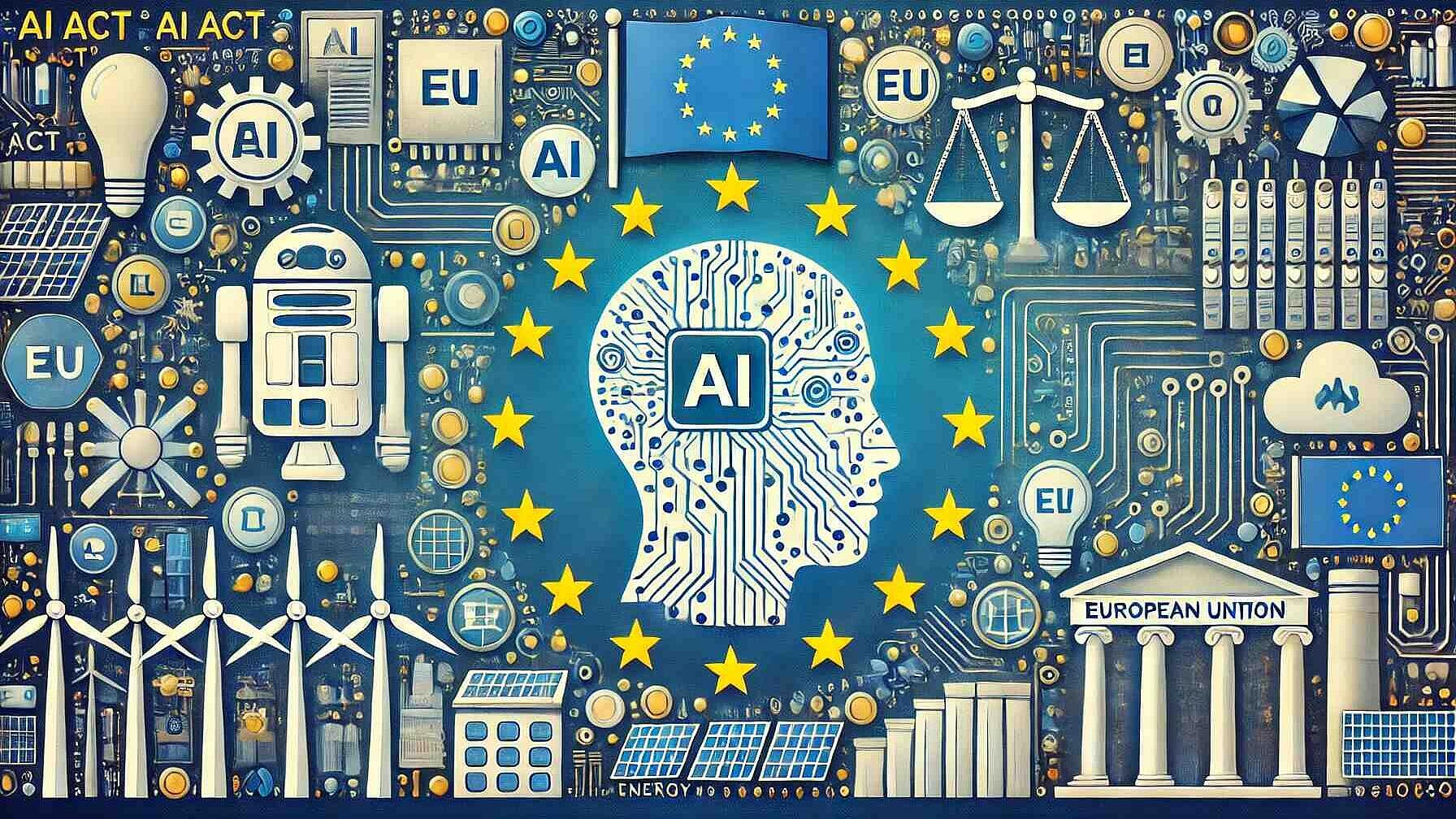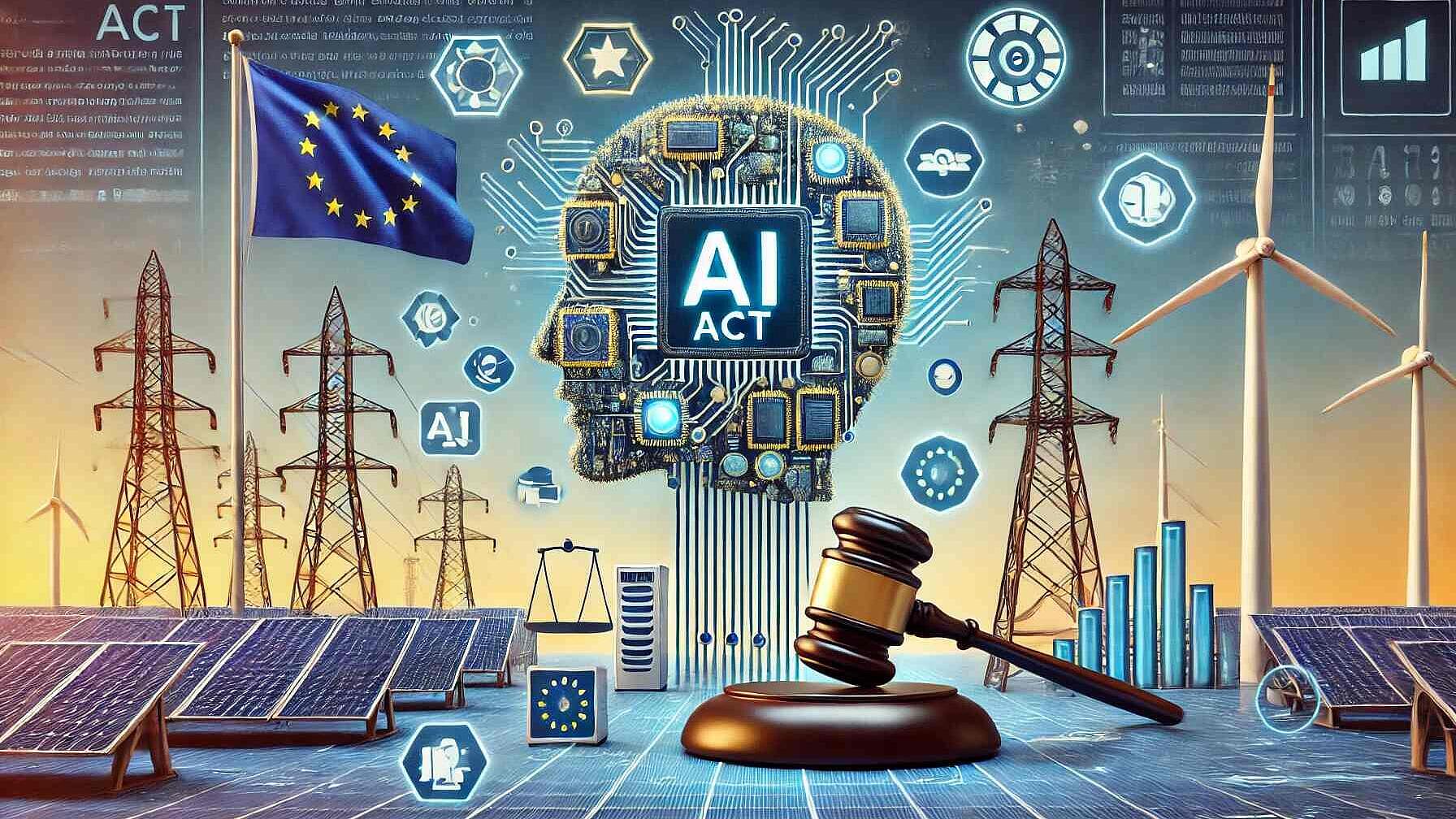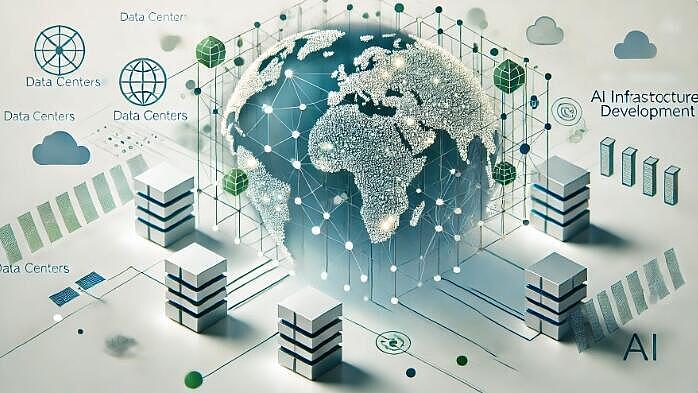 Política & Regulação
Política & RegulaçãoPráticas Comerciais
The Future of AI: Navigating the AI Act and its impact on energy transition
Resumo
The European Union's AI Act establishes a legal framework for AI that prioritizes human-centric and trustworthy development while safeguarding fundamental rights. It introduces a risk-based classification for AI systems, categorizing them into four levels (unacceptable, high, limited, minimal risk), with corresponding regulations. High-risk AI systems must adhere to stringent requirements, including risk management, data governance, and transparency. Compliance and enforcement are outlined with the creation of an AI Office and national authority roles, and non-compliance penalties are enforced to ensure accountability.
In the energy sector, AI has the potential to revolutionize supply chains, enhance efficiency, and integrate renewable sources. Smart grids managed by AI can improve reliability by balancing supply and demand in real time. AI-driven predictive maintenance can reduce downtime and maintenance costs, facilitating a smoother integration of renewable energies. On the demand side, AI enables energy optimization for consumers and industries through smart meters and energy management systems, promoting efficiency.
The International Energy Agency (IEA) recognizes AI's role in achieving energy efficiency and sustainability, highlighting the need for robust data governance and international cooperation. The AI Act is poised to foster responsible AI innovation, fully exploiting AI's benefits in sectors such as energy while ensuring ethical compliance and collaboration among stakeholders. Europe aspires to set a global benchmark for AI regulation through continuous policy and practice refinement.
Artigo aberto completo
The Future of AI: Navigating the AI Act and its impact on energy transition
Artificial Intelligence (AI) has rapidly evolved, permeating various sectors, and transforming how we live and work. With this growth comes the need for robust regulations to ensure the ethical and safe deployment of AI technologies. The European Union has taken a pioneering step with the AI Act, a comprehensive legislative framework aimed at regulating AI systems across the continent. This blog post delves into the top chapters of the AI Act, offering a summary and exploring its impact on the energy sector in Europe.
Chapter 1: General Provisions
The AI Act begins with a clear objective: to establish a uniform legal framework for the development, marketing, and use of AI systems within the European Union. It emphasizes the importance of promoting human-centric and trustworthy AI while safeguarding fundamental rights, health, safety, and environmental protection . The regulation aims to prevent Member States from imposing divergent restrictions, thereby ensuring the free movement of AI-based goods and services across the EU.
Key Points:
- Human-Centric Approach: Ensures AI development aligns with Union values.
- Legal Certainty: Provides a clear legal framework for AI developers and users.
- Fundamental Rights Protection: Prioritizes health, safety, and environmental protection.
Chapter 2: Risk-Based Classification of AI Systems
A cornerstone of the AI Act is its risk-based approach to classification. AI systems are categorized into four risk levels: unacceptable risk, high risk, limited risk, and minimal risk . This classification dictates the regulatory requirements each system must meet.
Key Points:
- Unacceptable Risk: Bans AI systems that pose a clear threat to safety, livelihoods, or rights.
- High-Risk Systems: Subject to stringent obligations, including conformity assessments and robust documentation.
- Limited and Minimal Risk: Face fewer requirements, focusing on transparency and accountability.
Chapter 3: Requirements for High-Risk AI Systems
High-risk AI systems, due to their potential impact on individuals and society, are subject to rigorous requirements. These include comprehensive risk management systems, data governance measures, and transparency obligations .
Key Points:
- Risk Management: Continuous monitoring and mitigation of risks associated with AI systems.
- Data Governance: Ensures high-quality data is used for training and testing AI models.
- Transparency: Requires clear documentation and communication about the AI system's capabilities and limitations.
Chapter 4: Compliance and Enforcement
The AI Act outlines the roles and responsibilities of national authorities and the newly established AI Office. It emphasizes the importance of robust compliance mechanisms and the enforcement of penalties for non-compliance .
Key Points:
- AI Office: Central authority for overseeing AI regulation across the EU.
- National Authorities: Responsible for monitoring and enforcing compliance within Member States.
- Penalties: Significant fines for breaches of the AI Act, ensuring deterrence and accountability.
Chapter 5: AI in Energy
The AI Act's implications extend to various sectors, including energy. The energy sector stands to benefit significantly from AI, with potential applications in optimizing supply chains, enhancing energy efficiency, and integrating renewable energy sources. However, the Act also introduces specific challenges and considerations for energy producers and consumers.
Supply Side Impact
AI can revolutionize the energy supply side by improving grid management, predicting energy demand, and enhancing the efficiency of renewable energy sources. Smart grids, powered by AI, can balance supply and demand in real-time, reducing energy waste and increasing reliability .
Key Points:
- Smart Grids: AI enables real-time monitoring and management, enhancing grid reliability and efficiency.
- Predictive Maintenance: AI-driven predictive analytics can foresee equipment failures, reducing downtime and maintenance costs.
- Renewable Integration: AI helps in seamlessly integrating renewable energy sources, improving their efficiency and reliability.
Demand Side Impact
For energy consumers, including industries, buildings, and transport, AI offers tools to optimize energy usage, reduce costs, and minimize environmental impact. Smart meters and AI-driven energy management systems can provide real-time insights into energy consumption, enabling better decision-making .
Key Points:
- Energy Management Systems: AI optimizes energy consumption in buildings and industrial processes, reducing costs and environmental impact.
- Smart Meters: Provide consumers with detailed insights into their energy usage patterns, promoting energy efficiency.
- Transport: AI supports the development of smart transportation systems, reducing energy consumption and emissions.
The Role of the International Energy Agency (IEA)
The IEA has been at the forefront of exploring the potential of AI in the energy sector. According to recent reports, AI could play a critical role in achieving energy efficiency and sustainability goals. The IEA highlights the importance of robust data governance and international cooperation to harness AI's full potential in the energy sector .
Key Points:
- Data Governance: Ensuring high-quality data is critical for effective AI deployment in energy.
- International Cooperation: Collaborative efforts are essential to standardize AI applications and share best practices across borders.
- Sustainability Goals: AI can significantly contribute to achieving global energy efficiency and sustainability targets.
Conclusion and Outlook
The AI Act represents a significant step towards ensuring that AI technologies are developed and used responsibly within the European Union. Its comprehensive framework aims to balance innovation with the protection of fundamental rights and safety. As AI continues to evolve, its impact on sectors like energy will be profound, offering opportunities for efficiency and sustainability. However, the challenges of compliance and ethical considerations will require ongoing attention and collaboration among stakeholders.
The future of AI regulation will likely involve continuous refinement of policies and practices to address emerging technologies and their implications. With the AI Act as a foundational framework, Europe is well-positioned to lead in the responsible development and deployment of AI, setting a global standard for others to follow.
A few remarks and a request at the end...
The first idea to this post (and the second one on the same topic...) links back to a short LinkedIn post from my old friend Oliver Sueme who is Partner and Tech & Data Lawyer at Fieldfisher. And it relates obviously to our work at EEIP on Digitalisation and specifically the use of AI. It is a two-fold journey. We are sharing solutions and good practices from the supply and demand side while at the same time exploring use cases for us at EEIP.
We have recently set-up our own AI POLICY, which we see as a starting point not only for guidance but even more as a tool to identify such policy guidelines make sense in terms of trust, transpacency and privacy. And where these guidelibes are likely limiting our growth opportunities opening up the discussion to keep the guidelines as is for good reason - or change them.
One EEIP use case you may have seen already is our new mobile quiz, a fast-paced 5 questions in 45 seconds game with leaderbords and prices. We use a quiz as an engagement tool in EU project EENOVA. And here we are using AI tools in the preparation of questions linked to explanations and full articles as well as translations.
Another way of testing is this article which is the twin article to The AI Act: Shaping Europe's Digital Future and Transforming the Energy Sector. The content part of the article summarising the key topics of the AI Act and exploring its impact on the supply and demand side is mainly AI generated. For this article we have used ChatGPT4.o. The starting point for both was the same prompt. So I am of course eager to hear which one you think is better (and why). Please feel free to drop me a line under my email.
Sources:
- International Energy Agency/ (various)
- AI Act


